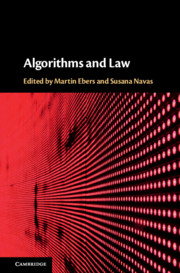Book contents
- Algorithms and Law
- Algorithms and Law
- Copyright page
- Contents
- List of Figures and Tables
- Notes on Contributors
- Preface
- Acknowledgments
- 1 Robotics and Artificial Intelligence
- 2 Regulating AI and Robotics
- 3 Regulating Algorithms
- 4 Automated Decision-Making under Article 22 GDPR
- 5 Robot Machines and Civil Liability
- 6 Extra-Contractual Liability for Wrongs Committed by Autonomous Systems
- 7 Control of Algorithms in Financial Markets
- 8 Creativity of Algorithms and Copyright Law
- 9 “Wake Neutrality” of Artificial Intelligence Devices
- 10 The (Envisaged) Legal Framework for Commercialisation of Digital Data within the EU
1 - Robotics and Artificial Intelligence
The Present and Future Visions
Published online by Cambridge University Press: 04 July 2020
- Algorithms and Law
- Algorithms and Law
- Copyright page
- Contents
- List of Figures and Tables
- Notes on Contributors
- Preface
- Acknowledgments
- 1 Robotics and Artificial Intelligence
- 2 Regulating AI and Robotics
- 3 Regulating Algorithms
- 4 Automated Decision-Making under Article 22 GDPR
- 5 Robot Machines and Civil Liability
- 6 Extra-Contractual Liability for Wrongs Committed by Autonomous Systems
- 7 Control of Algorithms in Financial Markets
- 8 Creativity of Algorithms and Copyright Law
- 9 “Wake Neutrality” of Artificial Intelligence Devices
- 10 The (Envisaged) Legal Framework for Commercialisation of Digital Data within the EU
Summary
The rise of artificial intelligence is mainly associated with software-based robotic systems such as mobile robots, unmanned aerial vehicles, and increasingly, semi-autonomous cars. However, the large gap between the algorithmic and physical worlds leaves existing systems still far from the vision of intelligent and human-friendly robots capable of interacting with and manipulating our human-centered world. The emerging discipline of machine intelligence (MI), unifying robotics and artificial intelligence, aims for trustworthy, embodiment-aware artificial intelligence that is conscious both of itself and its surroundings, adapting its systems to the interactive body it is controlling. The integration of AI and robotics with control, perception and machine-learning systems is crucial if these truly autonomous intelligent systems are to become a reality in our daily lives. Following a review of the history of machine intelligence dating back to its origins in the twelfth century, this chapter discusses the current state of robotics and AI, reviews key systems and modern research directions, outlines remaining challenges and envisages a future of man and machine that is yet to be built.
- Type
- Chapter
- Information
- Algorithms and Law , pp. 1 - 36Publisher: Cambridge University PressPrint publication year: 2020
- 3
- Cited by



